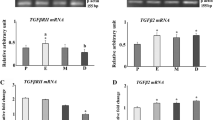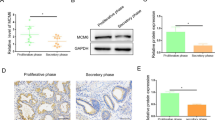Abstract
Proliferation of endometrial cells is a prerequisite step for functional differentiation in the uterus. A tumor suppressor gene, Cyclin-dependent kinase 2-associated protein 1 (Cdk2ap1) mRNA was detected in the pregnant uterus and was suggested to be involved in cell proliferation. However, its roles and the mechanisms regulating its expression are largely unknown. In this study, the role of steroid hormones in the expression of Cdk2ap1 was examined using RT-PCR, Northern blotting and in situ hybridization methods. Cdk2ap1 mRNA was highly expressed during the proestrus phase and was mainly localized in the epithelium and subepithelium. Its expression was induced by a single injection of estradiol and progesterone, but the effect of progesterone was stronger than that of estradiol. Injections of progesterone (P1,2) on 2 consecutive days induced Cdk2ap1 expression in the endometrium with the same patterns observed in the proestrus phase, but injections of estradiol (E1,2) on 2 consecutive days did not induce expression. The Cdk2ap1 mRNA level was decreased by combined treatment of progesterone and estradiol (E1+P2,3). RU486 suppressed completely the Cdk2ap1 mRNA expression in P1,2 while ICI 182,780 did not in E1+P2,3. In the uteri on day 4 of gestation, expression of Cdk2ap1 also was regulated by progesterone as expected. Cdk2ap1 mRNA expression was totally suppressed by RU486 but not by ICI 182,780. Thus, it is suggested that Cdk2ap1 expression is primarily regulated by progesterone and the progesterone receptor in uterus and is mainly localized to proliferating tissues.
Similar content being viewed by others
References
Bagchi I, Li Q, Cheon YP. Role of steroid hormone-regulated genes in implantation. Ann NY Acad Sci 2001, 943: 68–76.
Bagchi IC, Cheon YP, Li Q, Bagchi MK. Progesterone receptor-regulated gene networks in implantation. Front Biosci 2003, 8: s852–61.
Evans GS, Gibson DF, Roberts SA, Hind TM, Potten CS. Proliferative changes in the genital tissue of female mice during the oestrous cycle. Cell Tissue Kinet 1990, 23: 619–35.
Kimura J, Obata T, Okada H. Steroidal control mechanism of cell proliferation in mouse uterine epithelium. Endocrinol Jpn 1978, 25: 7–12.
Herken R. Cell kinetics of early gestation mouse uterus. Cell Tissue Kinet 1983, 16: 419–28.
McCormack JT, Greenwald GS. Evidence for a preimplantation rise in estradiol-17β levels on day 4 of pregnancy in the mouse. J Reprod Fertil 1974, 41: 297–301.
Cheon YP, Li Q, Xu X, DeMayo FJ, Bagchi IC, Bagchi MK. A genomic approach to identify novel progesterone receptor regulated pathways in the uterus during implantation. Mol Endocrinol 2002, 16: 2853–71.
Kim HS, Cheon YP. Spatio-temporal expression and regulation of dermatopontin in the early pregnant mouse uterus. Mol Cells 2006, 22: 262–8.
Pabona JM, Velarde MC, Zeng Z, Simmen FA, Simmen RC. Nuclear receptor co-regulator Krüppel-like factor 9 and prohibitin 2 expression in estrogen-inuced epithelial cell proliferation in the mouse uterus. J Endocrinol 2009, 200: 63–73.
Bazer FW, Spencer TE, Johnson GA, Burghardt RC, Wu G. Comparative aspects of implantation. Reproduction 2009, 138: 195–209.
Zhang Z, Laping J, Glasser S, Day P, Mulholland J. Mediators of estradiol-stimulated mitosis in the rat uterine luminal epithelium. Endocrinology 1998, 139: 961–6.
Huet-Hudson YM, Andrews GK, Dey SK. Cell type-specific localization of c-myc protein in the mouse uterus: modulation by steroid hormones and analysis of the periimplantation period. Endocrinology 1989, 125: 1683–90.
Enders AC, Schlafke S. Cytological aspects of trophoblast-uterine interaction in early implantation. Am J Anat 1969, 125: 1–29.
Rogers PA, Murphy CR, Rogers AW, Gannon BJ. Capillary patency and permeability in the endometrium surrounding the implanting rat blastocyst. Int J Microcirc Clin Exp 1983, 2: 241–9.
Pampfer S, Donnay I. Apoptosis at the time of embryo implantation in the mouse and rat. Cell Death Differ 1999, 6: 533–45.
Kleinfeld RG, O’Shea JD. Spatial and temporal patterns of deoxyribonucleic acid synthesis and mitosis in the endometrial stroma during decidualization in the pseudopregnant rat. Biol Reprod 1983, 28: 691–702.
O’Shea JD, Kleinfeld RG, Morrow HA. Ultrastructure of decidualization in the pesudopregnant rat. Am J Anat 1983, 166: 271–98.
Cheon YP. Expression of doc-1 in pregnant uterus of the mouse. Kor J Fertil Steril 2002, 29: 295–302.
Lee S, Lee SA, Shim C, et al. Identification of estrogen-regulated genes in the mouse uterus using a delayed-implantation model. Mol Reprod Dev 2003, 64: 405–13.
Baulieu EE. Contragestion and other clinical applications of RU486, and antiprogesterone at the receptor. Science 1989, 245: 1351–7.
Zolochevska O, Figueiredo ML. Expression of cell cycle regulator cdk2ap1 suppresses tumor cell phenotype by non-cell-autonomous mechanisms. Oral Oncol 2009, 45: e106–12.
Shintani S, Ohyama H, Zhang X, et al. p12DOC-1 is a novel cyclin-dependent kinase 2-associated protein. Mol Cell Biol 2000, 20: 6300–7.
Matsuo K, Shintani S, Tsuji T, et al. p12(DOC-1), a growth suppressor, associates with DNA polymerase alpha/primase. FASEB J 2000, 14: 1318–24.
Kim Y, Deshpande A, Dai Y, et al. Cyclin-dependent kinase 2-as-sociating protein 1 commits murine embryonic stem cell differentiation through retinoblastoma protein regulation. J Biol Chem 2009, 284: 23405–14.
Tsuji T, Ibaragi S, Shima K, et al. Epithelial-mesenchymal transition induced by growth suppressor p12CDK2-AP1 promotes tumor cell local invasion byt suppresses distant colony growth. Cancer Res 2008, 68: 10377–86.
Zysow BR, Kauser K, Lawn RM, Rubanyi GM. Effects of estrus cycle, ovariectomy and treatment with estrogen, tamoxifen, and progesterone on apolipoprotein (a) gene expression in transgenic mice. Arterioscler Thromb Vasc Biol 1997, 17: 1741–5.
Yoshinaga K, Hawkins RA, Stocker JF. Estrogen secretion by the rat ovary in vivo during the estrous cycle and pregnancy. Endocrinology 1969, 85: 103–12.
Wiest WG. Progesterone and 20-alpha-hydroxypregn-4-en-3-one in plasma, ovaries and uteri during pregnancy in the rat. Endocrinology 1970, 87: 43–8.
Todd R, McBride J, Tsuji T, et al. Deleted in oral cancer-1 (doc-1), a novel oral tumor suppressor gene. FASEB J 1995, 9: 1362–70.
Deshpande AM, Dai YS, Kim Y, et al. Cdk2ap1 is required for epigenetic silencing of Oct4 during murine embryonic stem cell differentiation. J Biol Chem 2009, 284: 6043–7.
Byun HS, Lee GS, Lee BM, et al. Implantation-related expression of epidermal growth factor family molecules and their regulation by progesterone in the pregnant rat. Reprod Sci 2008, 15: 678–89.
Kim MR, Park DW, Lee JH, et al. Progesterone-dependent release of transforming growth factor-beta1 from epithelial cells enhances the endometrial deciualization by turning on the Smad signaling in stromal cells. Mol Hum Reprod 2005, 11: 801–8.
Tachi C, Tachi S, Lindner HR. Modification by progesterone of oestradiol-induced cell proliferation, RNA synthesis and oestradiol distribution in the rat uterus. J Reprod Fertil 1972, 31: 59–76.
Clark BF. The effects of oestrogen and progesterone on uterine cell division and epithelial morphology in spayed, adrenalectomized rats. J Endocrinol 1971, 50: 527–8.
Baranda-Avila N, Mendoza-Rodríguez CA, Morimoto S, Langley E, Cerbón M. Molecular mechanism of cell proliferation in rodent uterus during the estrus cycle. J Steroid Biochem Mol Biol 2009, 113: 259–68.
Tsuji T, Duh FM, Latif F, et al. Cloning, mapping, expression, function, and mutation analysis of the human ortholog of the hamster putative tumor suppressor gene doc-1. J Biol Chem 1998, 2733: 6704–9.
Kim Y, McBride J, Kimlin L, Pae EK, Deshpande A, Wong DT. Targeted inactivation of p12, CDK2 associating protein 1, leads to early embryonic lethality. PLoS One 2009, 4: e4518.
Author information
Authors and Affiliations
Corresponding author
Rights and permissions
About this article
Cite this article
Cheon, Y.P., Kim, C.H. Progesterone is primary regulator of Cdk2ap1 gene expression and tissue-specific expression in the uterus. J Endocrinol Invest 33, 650–656 (2010). https://doi.org/10.1007/BF03346665
Published:
Issue Date:
DOI: https://doi.org/10.1007/BF03346665




